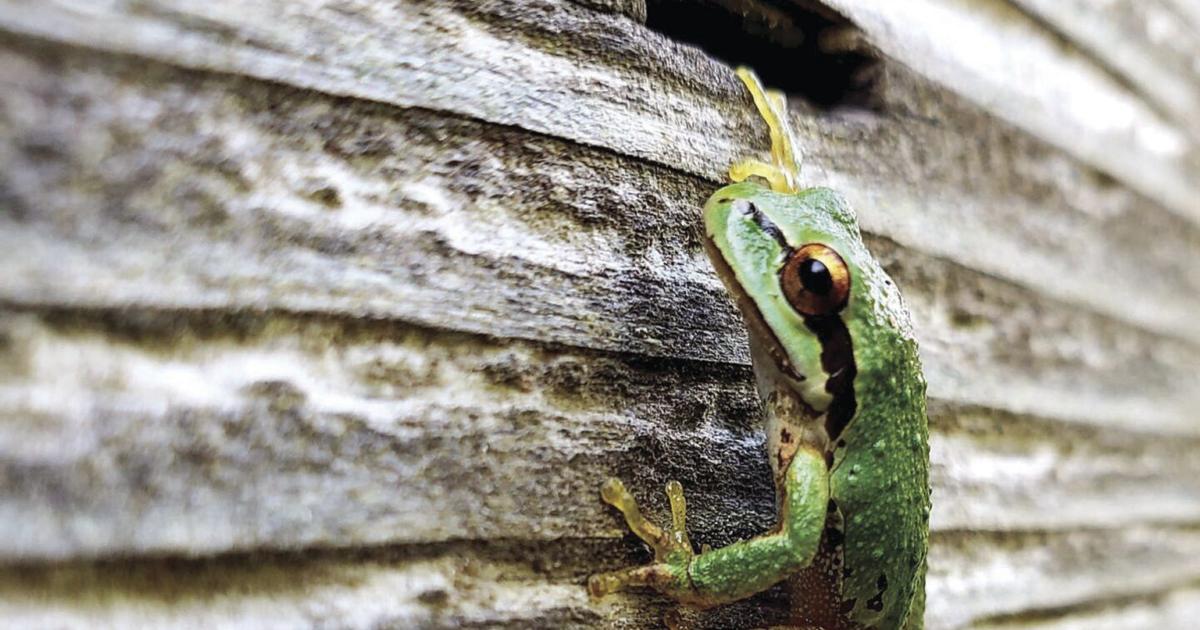You may have heard them in your neighborhood or while driving with your car windows down during our recent warm early-spring weather.
It’s frog-singing time!
The big voices are misleading: most of the frog song on the Oregon Coast is made by the tiny Pacific chorus frog that grows to no more than 2 inches long. (These frogs might go by two names, now called Pacific chorus frog, Pseudacris regilla, but previously called Pacific treefrog, Hyla regilla.) Oregon’s smallest and most common frog, Pacific chorus frogs come in a variety of colors, from bright green to mottled brown to wet-sand tan, but always sporting a characteristic narrow, dark stripe from the tip of the nose, through the eye and ear, to the shoulder. They can also change their color, varying with temperature and season.
From the Greek for “both lives,” “amphibian” refers to the animals’ two-phases: water-based larvae and tadpoles that metamorphose into land-based salamanders and frogs. (In addition to salamanders and frogs, there is a third group of amphibians, the caecilians, that live only in the tropics.)
Pacific chorus frogs lay their clear eggs in soft, tightly packed clusters, attaching them to submerged plants near the bottom of shallow ponds and pools. The tadpoles that hatch from the eggs develop into juvenile frogs in relatively short order—in two or three months—allowing them to use some temporary ponds as breeding sites. Young froglets usually remain in grassy or brushy areas near water, but adults may wander from wetlands.
Adult Pacific chorus frogs have special glands in their skin that produce a waxy coating that helps protect them from drying. With this increased tolerance, they can wander quite a distance from water through forests, meadows, city parks, backyards—even in the dunes on damp days.
Like most frogs and toads, Pacific chorus frogs are predators. Adults eat mostly insects and other small invertebrates by catching them with their tongues; their tadpoles eat large plankton, algae, and detritus (fine-grained organic debris).
While their body temperature is wholly dependent on environmental conditions (sometimes said to be “cold-blooded”), amphibians do manage their body temperature by moving about their environment. In the Pacific Northwest, they seek cool, damp burrows and crannies in summer, and search out well-insulated resting spots in winter.
Several people have told me that they used to hear more frogs in the spring than they do now. Quite likely true: Many species of amphibians are declining world-wide, including in Oregon—up to 40% of amphibian species world-wide are threatened or endangered. Much of the decline is attributed to loss of critical habitat, those boggy wetlands and swales people often undervalue. Other major threats to Oregon frogs include introduced bullfrogs (that eat just about everything), fungal infections on egg masses, and an increase in UV light.
Climate change is worsening the situations for frogs, making air and water too warm for them while encouraging fungal infections, decreasing available wet habitat in increasingly hot and long summers, and dragging out the start of cold winter, forcing them to stay active after food declines and robbing them of restful winter hibernation.
How does a two-inch frog make so much noise?
The singing is performed by inflating the throat then forcing air back and forth between the throat and lungs past the vocal cords, producing a “croak” as the air goes each direction. Our tiny frogs make so much noise, their calls have been recorded and used in movies.
So what’s all the singing about?
Male frogs sing to identify their species and sex, as well as to attract female frogs. Further, it appears that the frogs measure their population density by group singing, and somehow use the volume or number of voices they hear to adjust the overall population.
Frogs also adjust their population by hopping around the landscape, finding new ponds to lay their eggs in.
Hop on, frogs, and sing some more!
.

